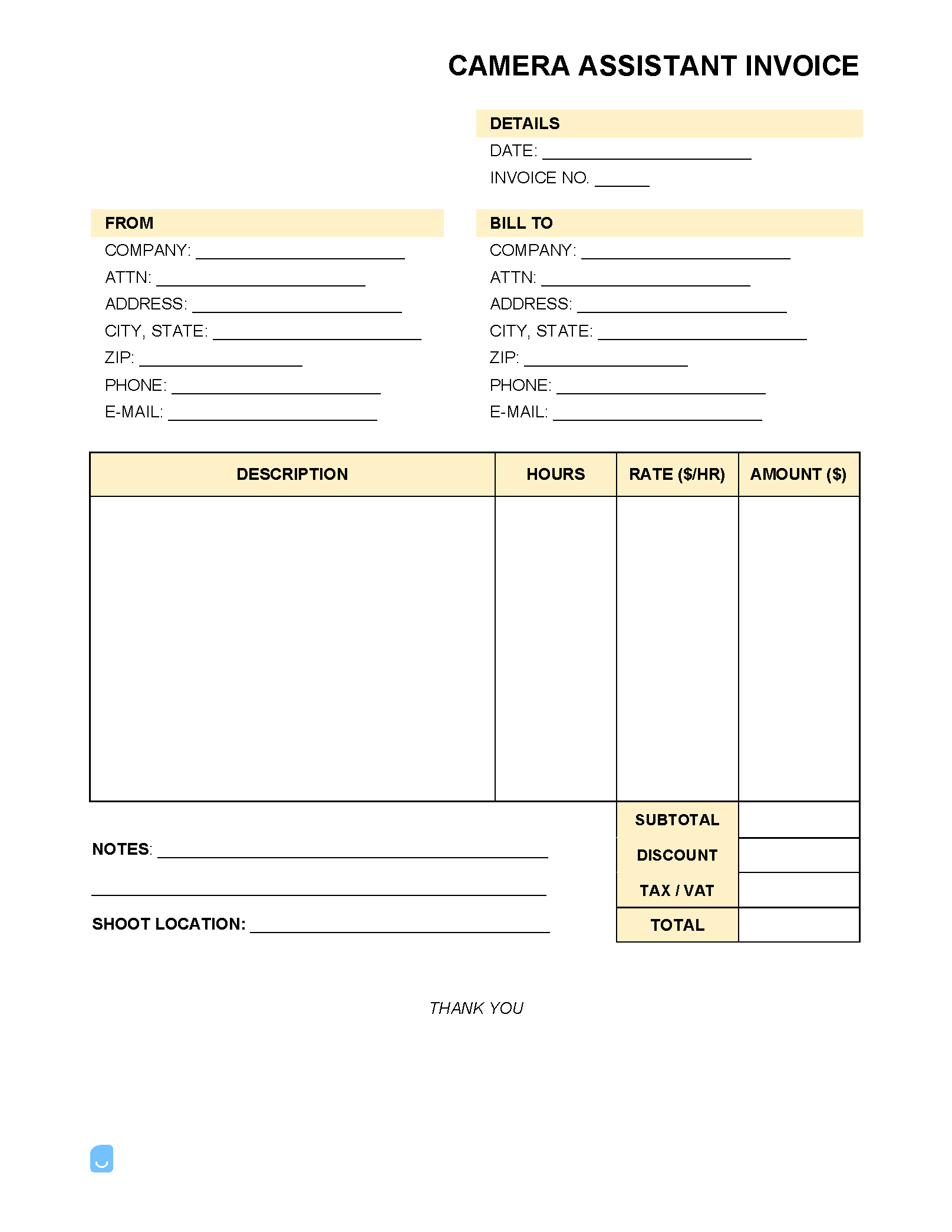Camera Assistant Invoice Template
A camera assistant invoice is used by freelance and contracted first (1st) and second (2nd) assistant camera operators to list the hours spent on set recording and handling the filming of a movie, television show, or other video production. Camera assistants aid camera operators and set directors with caring for film equipment, carrying cameras from location to location, keeping the camera in focus, and other tasks maintaining recording quality.

How to Create a Camera Assistant Invoice that Gets You Paid Quickly and Easily
A camera assistant invoice is a document that itemizes the services provided by a camera assistant. Camera assistants typically charge by the hour, with a minimum number of hours required. The balance is due upon completion of the project.
What is a Camera Assistant?
The camera assistant is a very important member of the film crew. They are responsible for the care and maintenance of the camera and all of its accessories. They also keep track of all the camera equipment and make sure that it is in good working order. The camera assistant is responsible for setting up the camera and making sure that it is properly aligned. They have to not only consider the operation of the camera but also the elements of sound, lighting, and visual effects. They also help to keep the camera operator and the director of photography in sync with each other.
First (1st) vs. Second (2nd) Assistant Camera
Although both the 1st and 2nd assistant cameras (ACs) fill vital roles in the production of a film, their tasks and responsibilities differ greatly.
First (1st) Assistant Camera
The first AC, also known as a “focus puller,” works alongside the camera operator to ensure the actors stay in focus for the duration of the shoot. This includes measuring the distance between the camera and scene and communicating on the fly with the camera operator and dolly grip. The act of keeping the lens in focus for repeated shoots is a task that requires a significant amount of experience and skill. In addition to maintaining focus, first ACs also responsible for assembling/disassembling cameras, moving them from one shoot to the next, and selecting the correct lens for the scene.
Second (2nd) Assistant Camera
The second AC ensures the cameras have sufficient film and charged batteries, are placed in the correct spots, and are adequately tested (cameras are often tested up to three (3) weeks before filming is scheduled to begin). The 1st AC and 2nd AC’s tasks can overlap in terms of the filming equipment, as both can have the task of choosing a lens for a scene and assembling equipment.
How to Become a Camera Assistant
Many camera assistants have backgrounds in studying videography, film production, journalism, photography, and other arts-related majors. Graduates often look for open entry-level positions where they can shadow an experienced camera assistant or operator. Landing a position as a camera assistant directly out of school is difficult, if not impossible, due to the real-world skills and experience typically required of both first and second assistant cameras. Sometimes the best way to gain experience is to do some work for free.
Camera Assistant Salary & Hourly Rate ($/hr)
Due to the freelance nature of the profession, the salary of a CA can vary significantly from one to the next, depending on the number of jobs they are hired for. Additionally, the level of experience can have a big impact on the hourly rate earned. According to the Bureau of Labor Statistics on “Film and Video Editors and Camera Operators” (which also include Camera Assistants), this is their average salary and hourly rates:
Minimum Day Rate for a Camera Assistant
There is no one-size-fits-all answer to this question, as the rates for a camera assistant can vary depending on a number of factors, including the specific job duties required, the location of the shoot, the length of the shoot, and the experience of the assistant. However, as a general range, camera assistants typically earn between $400 and $700 per day.
Key Features of a Camera Assistant Invoice
A camera assistant should invoice for hours worked and make sure to include all relevant details on the billing document. The invoice should typically include:
- Name and contact information (e.g. street address, phone number, email) for camera assistant
- Logo (if applicable)
- Name and contact details (e.g. mailing address, phone number, email) for production company
- Invoice number
- Date
- Description of services rendered/hours worked
- Day rate/costs associated with services rendered
- Total amount due
- Payment methods accepted (e.g. credit card, PayPal)
- Applicable taxes
A computer program such as Microsoft Word or Microsoft Excel can be used to generate invoices manually. Invoicing software or an easy-to-use online invoice generator can be the simplest, most hassle-free option.